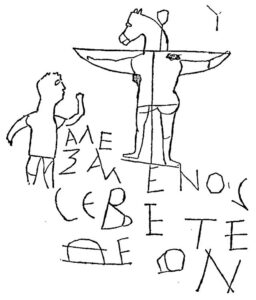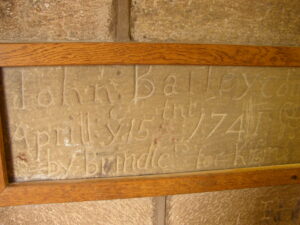Colin Penny lived up to expectations and delivered an excellent and very interesting talk. He began with asking “What is Graffiti” of course everyone has their own ideas on this subject. Essentially it is leaving a mark in a public place, until recently, that is, 150 years ago it was not illegal to graffiti.

Graffito_d’Alexamenos.
Public domain.
Is Banksy a graffiti artist? His ID is still a mystery yet his works have sold well, one for over a million pounds and that piece was shredded! Being sold at Sotheby’s must indicate that his graffiti has become ‘art’. Apparently he creates a stencil beforehand, then colours it in insitu, which enables him to disappear quickly.
Why do people graffiti? There are many reasons, rebellion, the need to shock society, love, hate, outrage, political reasons or mere boredom. When does graffiti stop being a nuisance and become interesting? Colin intrigued us with the story of a young American soldier in WWI, he left his name and date on a building in a French village, in WWII he happened to be passing through the same village again and again left his name and the date, under this he wrote.. “and I don’t want to write on here again”.
He went on to talk about how graffiti informs of of natural events, like the plague “..in 1350 a pitiable, fierce, violent plague departed” and from the same priest in 1361 “there was a mighty wind”, reminding us of Michael Fish’s comment that there was no hurricane on the way in 1987. From Egyptians, Romans, Mediaeval times to the Vikings and onto contemporary graffiti he kept us fascinated. We spent a worthwhile hour on a lovely spring afternoon.

Historic Graffiti. 2022. Courtesy of Colin Penny.
And did you know?
Crusader Vikings spent time in the burial chamber at Maeshowe – Orkneys waiting out a storm by graffiting the walls. Apparently exactly the same graffiti appeared in Hagia Sophia, Constantinople which they must have visited on their way to the Holy Land. How thrilling is that?
Banner Image: Runes at Maeshowe. Attribution: Magnus Olsen.